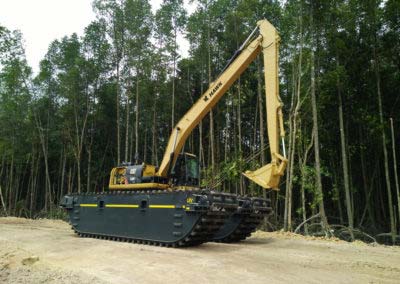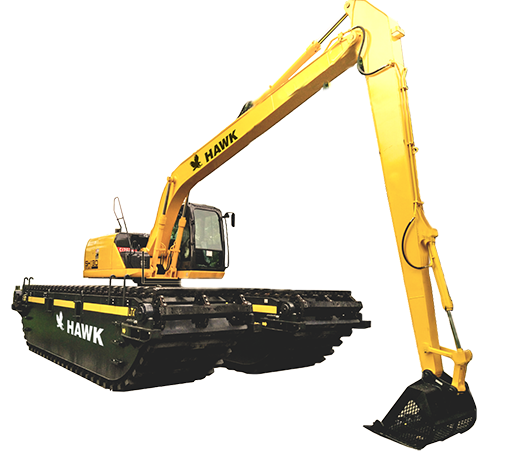Amphibious Excavators – The Dredging Giant
The Amphibious excavator, or a swamp excavator or floating excavator, is purpose-built dredging equipment designed to operate in demanding landscapes such as wetlands, swamps, and marshes.
These long-arm excavators are giant machines and highly adaptable compared to conventional excavators. They are used in construction projects, dredging, and environmental rehabilitation industries.
Amphibious excavators, equipped with a specialized undercarriage, operate in challenging and often harsh environments, such as soft terrain, swamps, marshes, and shallow water dredging projects. This unique setting exposes them to mud, water, and debris, accelerating wear and tear on the excavator accessories.
The amphibious undercarriage, which typically includes specialized floating excavators and additional hydraulic systems, is a crucial component that demands meticulous care.
Regular checks and maintenance of the pontoons are necessary to prevent water ingress, which could lead to buoyancy issues and potential operational failure.
Additionally, the hydraulic systems must be frequently inspected for leaks and contamination to maintain the smooth operation of the undercarriage movement.
Proper maintenance of amphibious excavators also involves regular cleaning to remove any sediment and debris that might have accumulated, which helps prevent corrosion and mechanical blockages.
This rigorous maintenance schedule enhances the equipment’s efficiency and reliability and extends its service life, ensuring it remains a valuable asset in the fleet.
These maintenance practices are vital to avoid downtime and costly repairs, supporting continuous and effective operation in low ground pressure and demanding aquatic environments.
Challenges in Maintaining Amphibious Excavators:
Amphibious excavators consistently face the common concern of corrosion due to their exposure to shallow water. This exposure can lead to decay, cracks, and fatigue in the metal components. Corrosion can damage the excavator’s structure, leading to early failure and maintenance problems.
Engine problems can occur in amphibious excavators due to overheating and fuel leaks.
Hydraulic system problems can arise from leaks, pollution, and erosion that reduce efficiency and potential breakdowns. Regular maintenance and fluid analysis are essential to stop hydraulic failures that can damage equipment.
Some specialized tools and procedures for maintaining amphibious excavators require training, making it challenging to find qualified technicians to perform maintenance.
The electrical system’s reliability is most important. Connections or damaged wiring faults can lead to malfunctions. Electrical system failures cause equipment breakdowns, so maintenance and monitoring are essential.
Amphibious excavators are complex machines with many moving parts like amphibious tracks, making diagnosis and repair challenging.
Regular track maintenance is essential because we use amphibious excavators in harsh conditions. The amphibious undercarriage can become misaligned and worn out due to ground pressure in wetlands and mud, so keeping it in good working condition is necessary.

Challenges in Maintaining Amphibious Excavators
How to Conquer Maintenance Challenges for Seamless Operations?
Regular oil and filter changes:
They are essential because of harsh conditions and rough materials. Therefore, it is necessary to inspect and change the worn-out parts promptly. Oil and filter changes help to keep the engine clean and running smoothly.
Checking and adjusting hydraulic fluid levels:
Proactive maintenance and fluid analysis in swamp buggies are essential to ensure proper hydraulic system operation.
Regularly checking and cleaning air filters is essential.
It involves changing oil, replacing filters, inspecting, and cleaning. This helps prevent dirt and debris from entering the engine of these swamp buggies, which can cause overheating and reduce power.
Checking and adjusting tire pressure:
Regularly check the tire pressure to ensure the excavator operates safely.
Electrical system reliability:
Routine inspections and preventive maintenance are vital to avoid electrical mishaps. Proper checks of switches & wires keep the electrical system secure.
Track maintenance
: Regular inspections, tension adjustments, and timely replacements prevent accidents and costly downtime.

How to Conquer Maintenance Challenges for Seamless Operations?
Some additional tips for minimizing maintenance problems with amphibious excavators:
Use the amphibious excavator responsibly:
Operate the floating excavator within its recommended limits to maintain safety and condition. Avoid excessive use in harsh conditions, which can cause premature wear and tear. Adhering to the manufacturer’s guidelines helps ensure optimal performance and longevity.
Keep the amphibious undercarriage clean:
The amphibious undercarriage is prone to accumulating dirt and debris, particularly in muddy or aquatic environments. Regular cleaning is crucial to remove materials that could cause blockages or abrasions, preventing early damage and maintaining the system’s efficiency.
Store the excavator properly:
When not in use, store the excavator in a dry, well-ventilated area to prevent rust and corrosion. Moisture can damage mechanical and electrical components, so a dry storage environment is essential for preserving the excavator’s integrity and extending its lifespan.
Schedule regular check-ups:
Have a skilled technician perform regular inspections to detect and address potential issues early. These check-ups should cover mechanical and hydraulic systems to minimize downtime and reduce repair costs.
Maintain the amphibious undercarriage:
Regular lubrication and inspection of the amphibious undercarriage are necessary to ensure its longevity and functionality. Pay special attention to the pontoon seals and joints to maintain the excavator’s buoyancy and stability and prevent water ingress that could lead to operational failures.
Advantages of HAWK’s Amphibious Excavators to overcome maintenance problems
HAWK’s amphibious excavators offer numerous technical advantages that make them valuable in specific applications.
HAWK‘s amphibious excavators have high-quality components to withstand harsh environments and rigors. This works as a preventive measure to minimize the risk of wear and tear.
HAWK makes strong amphibious excavators that handle water, dirt, and debris. This protects them from harm and helps them stay in good condition for a long time.
HAWK designs its amphibious excavators to be easy to maintain. The engine and other essential parts are easy to reach, making routine maintenance tasks fast and simple.
HAWK equips its amphibious excavators with advanced technology that helps prevent maintenance problems. The amphibious undercarriage has an engine with a diagnostic system that can warn the operator about possible issues before they happen.
HAWK designs its amphibious excavators to have a long service life. With proper maintenance, these excavators can last for many years.
Overall, HAWK’s amphibious excavators are reliable and durable tools for various applications. They are good for operators who want to minimize maintenance challenges in harsh and wet environments. They have high-quality components, durable construction, and easy maintenance.
Here are some specific examples of how HAWK’s amphibious excavators have helped to resolve maintenance challenges:
The construction company utilized a HAWK amphibious excavator for the river bridge construction. The ability of the amphibious undercarriage to operate in water and land made it perfect for the project. The excavator’s high-quality components and durable construction prevented maintenance issues throughout the project.
A mining company employed a HAWK amphibious excavator for coal mine excavation in rugged terrain. Operating in water, it provided more accessible access to the coal seams, and the excavator’s advanced technology prevented maintenance problems throughout the project.
A disaster relief agency utilized a HAWK amphibious excavator to clear flood debris. The amphibious undercarriage’s operation in the water allowed easy access to perform dredging to affected areas, and its easy maintenance ensured quick and efficient performance throughout the project.

Advantages of HAWK’s Amphibious Excavators to overcome maintenance problems
Applications of HAWK’s amphibious excavators
-Wetland infrastructure development.
-Excavating and leveling the foundation area in construction projects.
-To remove silt and debris from shallow water bodies efficiently through dredging.
-Environmental restoration by rehabilitating wetlands and floodplains.
-Disaster response for rescue operations and debris removal during floods and wet environments.
-Supporting agricultural activities by maintaining irrigation channels and dredging ponds.
-Assists in exploration and pipeline installation in swampy areas’ oil and gas industry.
Conclusion
In conclusion, the unique challenges of operating and maintaining amphibious excavators demand careful attention to their design and environmental needs. Regular maintenance, responsible usage, and proper storage are essential for optimal performance and longevity of the amphibious machine.
HAWK’s amphibious excavators are tailored for harsh environments with features that simplify maintenance, enhance durability, and minimize downtime. Their robust construction and advanced diagnostics systems make them well-suited for rugged terrains.
These machines are invaluable in construction, mining, and disaster response, delivering high efficiency and productivity even in challenging conditions. HAWK’s commitment to technological advancement ensures these excavators perform effectively while preserving ecological balances.
Overall, HAWK’s innovations in amphibious excavator design ensure they remain essential in modern dredging and excavation, effectively meeting the industry’s evolving demands and ensuring progress across various critical sectors.
Hawk Excavator’s Top Products
HAWK’s Long Reach Arm System ensures superior performance, reliability, and durability. It can precisely handle dredging, habitat restoration, and construction projects in water and delicate environments.
Engineered for excellence, this cutting-edge attachment extends the reach of your machine, maximizing efficiency and productivity. Experience unmatched range and transform your excavator into an unstoppable force for any job. Elevate your capabilities and explore new possibilities with HAWK’s Long Reach Arm System.
HAWK Vision RTK GPS Positioning Systems
HAWK Vision RTK GPS Systems are highly reliable and perform well in various industries like surveying, construction, agriculture, and mining. They easily integrate with your current equipment. These state-of-the-art systems provide real-time kinematic (RTK) capabilities, ensuring centimeter-level accuracy for your equipment.
Excavator attachments by HAWK
HAWK Excavator Attachments handle various tasks easily, like construction, demolition, forestry, and material handling, to improve efficiency and get great outcomes.
The Hydraulic Breaker Hammer unleashes formidable force, demolishing rigid materials with ease. General Digging Buckets offer reliable performance, excelling in earthmoving and excavation tasks.
Grapples offer flexibility for handling materials and forestry tasks. We carefully make each attachment strong and accurate so it fits well with your excavator.
FAQs
1. What is the functioning mechanism of an amphibious excavator?
An amphibious excavator has unique attachments, like pontoons or tracks, to float on water. These features allow the excavator to navigate swamps, marshlands, and shallow water, enhancing its flexibility for various water-based tasks.
2. What are the advantages of using an HAWK’s amphibious excavator over a standard excavator?
The main advantage of a HAWK’s amphibious excavator is its ability to work on both land and water. It is excellent for dredging, wetland restoration, shoreline maintenance, and other water projects, allowing access to difficult areas. Amphibious excavators are better for the environment in sensitive areas because they have less ground pressure than regular excavators.
3. How does the buoyancy of amphibious excavators work, and what safety measures should operators follow when working on water?
Amphibious excavators stay afloat with unique designs & attachments that have pontoons or tracks to displace water. Operators need training for working on the water.
Individuals should wear personal flotation devices (PFDs) or life vests. They need to stay away from the water’s edge. Additionally, they must follow safety guidelines.
4. How do I transport an amphibious excavator between job sites?
Trucks equipped with trailers or floating on the water can transport amphibious excavators. Designers create some models to disassemble them for more accessible transportation.
5. Which projects do amphibious excavators suit best, and what attachments can you use with them?
HAWK’s Amphibious Excavators excel in pond and lake dredging, wetland restoration, environmental cleanup, and shoreline maintenance. They can have different attachments like long arms for reaching far, grapples for handling materials, and buckets for removing sediment. This makes them useful for many different tasks.

